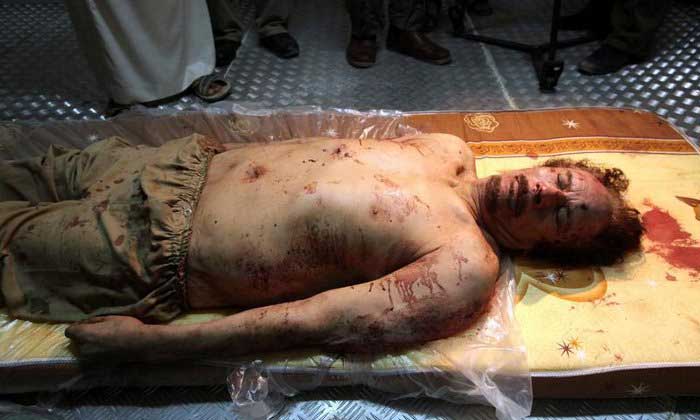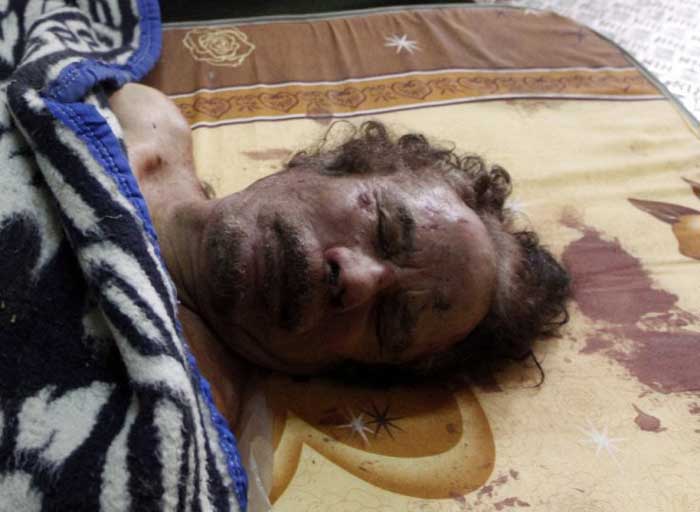Muammar Gaddafi death

After the fall of Tripoli to forces of the opposition National Transitional Council (NTC) in August 2011, Muammar Gaddafi, the deposed leader of Libya, and his family fled the Libyan capital. He was widely rumoured to have taken refuge in the south of the country and in fact Gaddafi had fled in a small convoy to Sirte on the day Tripoli fell.

On October 19, Libya’s acting prime minister Mahmoud Jibril said that the former leader was believed to be in the southern desert, organising an insurgency among pro-Gaddafi tribes in the region. By that point the NTC had just taken control of the pro-Gaddafi town of Bani Walid and were close to taking control of Gaddafi’s home town, the tribal heartland of Sirte east of Tripoli. According to most accounts, Gaddafi had been with heavily armed regime loyalists in several buildings in Sirte for several months as NTC forces took the city. Mansour Dhao, a member of Gaddafi’s inner circle and leader of the regime’s People’s Guard, said that Gaddafi was very delusional and complained about the lack of electricity and water. Any attempts to persuade him to flee the country and give up power were ignored. As the last loyalist district of Sirte fell, Gaddafi and other members of the government attempted to flee.
At around 8:30 local time (6:30 UTC) on October 20, Gaddafi, his army chief Abu-Bakr Yunis Jabr, his security chief Mansour Dhao, and a group of loyalists attempted to escape in a convoy of 75 vehicles. A Royal Air Force reconnaissance aircraft spotted the convoy moving at high speed, after NATO forces intercepted a satellite phone call made by Gaddafi. NATO aircraft then fired on 11 of the vehicles, destroying one. According to their statement, NATO was not aware at the time of the strike that Gaddafi was in the convoy. NATO stated that in accordance with Security Council Resolution 1973, it does not target individuals but only military assets that pose a threat. NATO later learned, “from open sources and Allied intelligence,” that Gaddafi was in the convoy and that the strike likely contributed to his capture.

Gaddafi was killed shortly afterwards. There are conflicting reports; according to one report, Gaddafi said “Please don’t shoot!” prior to being shot, and when questioned by Misratan rebel fighters about the damage done to Misrata by his forces, denied any involvement, and begged his captors not to hit him or kill him. One fighter demanded Gaddafi stand up, but he struggled to do so. Gaddafi can be heard in one video saying “God forbids this” and “Do you know right from wrong?” when being shouted at by his captors. In a video of his arrest he can be seen draped on the hood of a car, held by rebel fighters. A senior NTC official said that no order was given to execute Gaddafi. According to another NTC source, “they captured him alive and while he was being taken away, they beat him and then they killed him”. Mahmoud Jibril gave an alternative account, stating that “when the car was moving it was caught in crossfire between the revolutionaries and Gaddafi forces in which he was hit by a bullet in the head.”
Several videos related to the death were broadcast by news channels and circulated via the internet. The first shows footage of Gaddafi alive, his face and shirt bloodied, stumbling and being dragged toward an ambulance by armed men chanting “God is great” in Arabic. The video appears to picture Gaddafi being poked or stabbed in the rear “with some kind of stick or knife” or possibly a bayonet. Another shows Gaddafi, stripped to the waist, suffering from an apparent gunshot wound to the head, and in a pool of blood, together with jubilant fighters firing automatic weapons in the air. A third video, posted on YouTube, shows fighters “hovering around his lifeless-looking body, posing for photographs and yanking his limp head up and down by the hair.” Another video taken, most likely after his death, shows him being stripped naked and jeered at by his captors.
